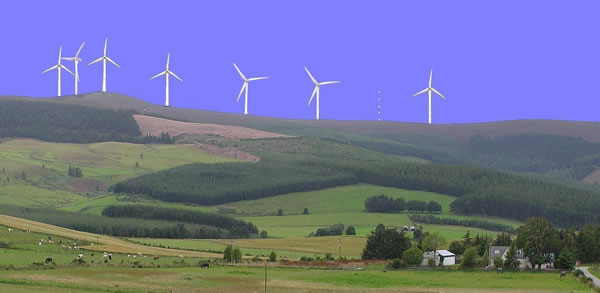
This week's TIME magazine, states on the front cover that “Politicians and Big Business are pushing biofuels like corn-based ethanol as alternatives to oil. All they’re really doing is driving up world fuel prices, helping destroy the Amazon jungle, and making global warming worse.” Here is Scotland our approach to the building of windmills is just about as mis-guided because of the lack of an Alternative Energy Strategy for Scotland. Scotland needs to hammer out a nation-wide policy for the development of alternative energies, based on the zoning principle. Until we do so we are un-necessarily damaging our greatest asset which is our wild lands that underpins our greatest employer - the Tourism Industry. Everyone agrees we need to develop our alternative energy potential, so let’s get the act together, and stop this piecemeal approach. We have apparently agreed what proportion of our power generation HAS to come from alternative energies. Let us sit down with a map of Scotland (OK do formal consultation etc, etc) and prioritise where we are going to harness this power from, and on what grounds.
(a) Planning Application for a Windfarm at Pressendye
Preceded by a photograph of what the skyline would look like if the Pressendye
Planning Application did go-ahead, here is a copy of NEMT’s letter to Aberdeenshire
Council opposing the planned development.

Photo supplied by Bob Humphreys
|
Head of Development Management & Building Standards
25th February 2008 Dear Sir, Proposed Windfarm – Pressendye We understand that planning application has been lodged for the above and that objections must be lodged by 28th February. As a trust, our main objective is to protect from potentially damaging developments, the upland and coastal environments of Scotland, and in particular, the North-East of Scotland, for the benefit of all taking recreation there both now and in the future. To this end, we do accept the need for a renewable energy policy, BUT, deem it necessary that a positive nationwide policy of zoning should be adopted, rather than the current piecemeal approach which brings into question the efficacy of the whole. Consequently, we have grave reservations regarding the scale and positioning of the proposed windfarm’s turbines on Pressendye. At a height of 125m (410 feet), the blades will add almost 50% to the height differential between the farms surrounding the southern slopes of the hill mass and its summit, increasing the overall height to almost 760m (2500 feet). This would, presumably, exclude the additional height of suitably positioned aircraft warning masts in an area prone to military low-flying exercises? Pressendye is situated on the northern edge of the Howe of Cromar, an area of outstanding bio-diversity and natural beauty as seen from many quarters. Indeed, the additional height would bring the blades up towards the level of the nearby Corbett – Morven at 871m (2860 feet) – in an area frequented by a locally run gliding club of national, if not international significance. The visual impact of what will effectively be an unscreened line of turbines would be considerable and excessive, not only from within many parts of the Cairngorm National Park to the west, but also from lesser heights and lower levels to the north, south and east. Crossing from the Boig farm near Tarland, a Right of Way crosses the ridge via Humphrey’s Well to Cushnie. This route and the well are very close to the line of the turbines and it must be asked whether or not, consideration has been given to this factor or to the noise pollution from the blades. On the day of a recent visit, the whine of the wind whistling through the struts of the recently installed weather mast could be heard quite clearly – even from an up-wind position. Typical of the area within and surrounding Royal Deeside – a long term tourist mecca – there is a proliferation and diversification of wildlife: - fur, feather and invertebrate. If the project were to go ahead, what would the impact be a) during the construction phase and b) from the turbine movement and maintenance? Does one assume that an intrusive and probably obtrusive access road would have to be built from the north quarter? The area is rich in natural diversity, ranging from the Mountain Hare – a threatened species, to the head of the raptor chain – the Golden Eagle, another species having problems in holding its own. Do we wish to accelerate their decline for minimal or indeed questionable gain? The overall impression is that inadequate consideration has been given to the fine balance between questionable commercial gain and the spoliation of a diversely widespread area of natural, tourist and aesthetic importance. Yours faithfully,
|
Please let the webmaster know if there are problems with viewing these pages or with the links they contain.